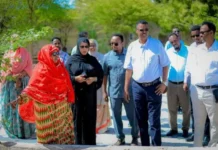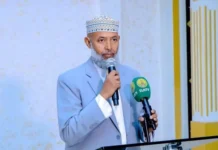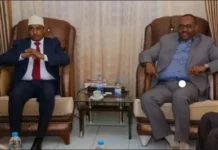The intensive military civil war had officially broken out in May 1988 when Barre bombarded Hargeisa and other northern cities. Less known is what precipitated the government’s bombing. What happened was this: a month earlier, in April 1988, Siad Barre had signed a so-called peace accord with Ethiopia. Their agreement required each country to terminate support for the other’s opposition parties. In other words, Ethiopia would no longer provide safe harbor for the SNM. Barre thought this would be the end of the SNM.
There is a Somali proverb that says ‘Do not dig a malicious hole, but if you do, do not make it deep, you never know you might end up being in the hole yourself ‘ (God haddimo ha qodin, hadaad qodidna ha dheereyn, ku dhici doontaana mooyee). That’s exactly what happened to Barre. By moving to oust the SNM from Ethiopia, he essentially began digging a big hole into which he himself would eventually fall. Because once the SNM were no longer welcome in Ethiopia, they moved into northern Somalia, attacking Barre’s regime in major cities such as Hargeisa and Burao.
In retaliation, the government sent air force pilots to shell Hargeisa to destruction. Because the SNM was comprised primarily of members of the Isaaq clan, the regime also took retaliatory actions against civilians in cities and towns in the north who might be Isaaq.
In fact, when the civil war had first broke out in the north and more than 160 foreigners had evacuated, the Somali government had issued an ultimatum. The workers were either to return to the war zone in the north or leave the country. Western donor nations condemned such an ultimatum, and The European Economic Commission had protested the order, and called it “astonishing.” As a result, the government’s threat had actually backfired, revealing them as powerless.
Sometimes it was not even clear anymore who was fighting whom. Mayhem and chaos had taken over. Several dozen people had been killed in heavy fighting between government troops and an armed gang who’d attacked a fuel depot in a northern Mogadishu. Security forces had made many arrests, and ambulances were carrying wounded soldiers to the government hospital. The next week, eight policemen were killed in an ambush, sending heavily armed police officers to search areas in Mogadishu for arms and explosives. Western embassies and most foreign aid organizations had by now evacuated all nonessential staff.
In a desperate move, Barre’s government announced they were legalizing political opposition groups for the first time in 17 years. The SNM rejected this offer as a ploy. With USC attacking Mogadishu in the South, the SNM had been preparing for its last offensive attack in the north.
In the consequent days, the SNM continued their attacks and seized major northern cities: Hargeisa and Buroa. When General Aideed and the USC heard about the capture of the north they were encouraged to intensify their battle. Collapse was imminent now. A stream of refugees had been pouring out of Somalia into both Ethiopia and Kenya, some of them highly placed military and political figures. Two-thirds of Mogadishu’s approximately one-million inhabitants had fled during the fighting.
By now Washington had cut ties with Siad Barre under a pressure from Congress, which had cited Mr. Barre’s brutal treatment of civilians who belonged to clans other than his own. Washington reduced military and economic aid to Somalia virtually zero over the two years before Barre’s departure. But the legacy of arms donations by the two superpowers continued to have a major impact.
Due to the arms donations from The United States and before that, the Soviet Union, civilians were able to buy rifles and mortars in the markets of the city. And in the days before Mr. Barre fled, the president’s forces had been indiscriminately shelling the city, killing thousands of people.
Four days after SNM’s capture of the north, on January 27, 1991, the USC declared control of Mogadishu. Siad Barre was said to have been forced to flee his palace. One report confirmed that he’d fled in a tank just 15 minutes before the troops stormed in. Another report said he’d fled to his well-fortified bunker near the capital’s airport. Had Siad Barre, who had once had a vision for a united Somali, ever expected this day would come? No one could imagine the shame he was feeling. As a Somali proverb says: the restless foot comes across trouble. [lit: shame] (Cagtii joogsan weyda marbay ceeb la kulantaa). Barre had become much too restless for too long a time and now he was in trouble.
The USC made an address on Radio Mogadishu. We are now in charge, they said. Siad Barre is no longer in control. The sky over Mogadishu was filled with tracer bullets as armed USC and other rebels all over the capital celebrated their victory. Very soon after their address, intense fighting and looting started in the city. When a BBC interviewer asked a British pilot, Murray Watson, one of the few Westerners still stationed in Mogadishu, whether there were many dead bodies in the streets due to the intense shelling that had been going on, Mr. Watson replied that “there are not so many bodies. . . because dogs have eaten most of them.” Unfortunately, we can all learn a lot from this story.
By: Jamal Ali Hussein






































